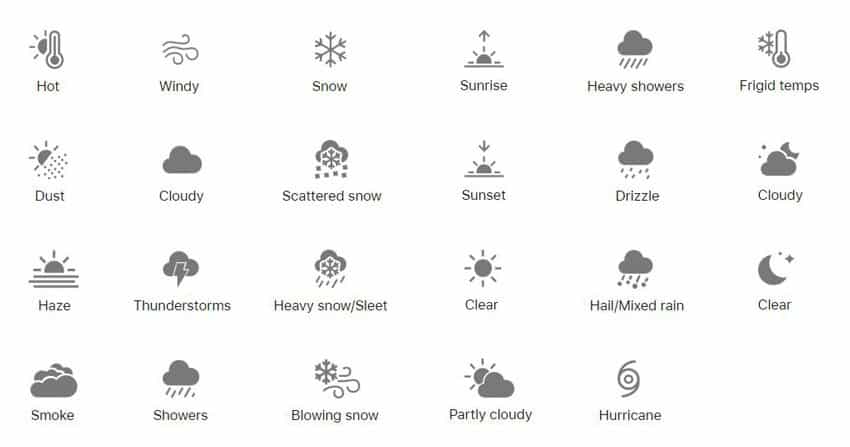Understanding Weather Symbols Used In Forecasts To Know What To Expect From Future Atmospheric Conditions
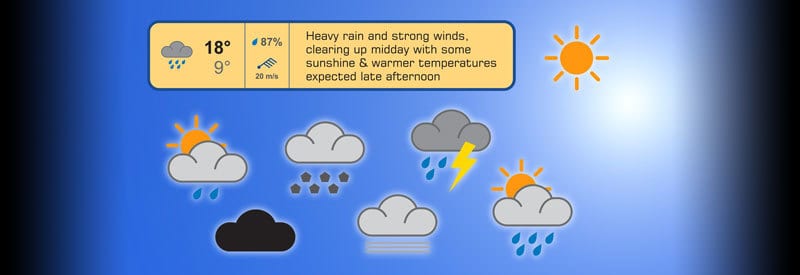
Most readers will be familiar with the symbols used in television and online weather forecasts, mobile apps, and printed media. Some of these symbols, though, may often appear confusing or unclear.
And you know what? You are definitely not alone and have absolutely nothing to feel embarrassed about! In fact, a huge percentage of people regularly watching weather forecasts are often confused by the different symbols and terminologies used by the various weather services.
What Are Weather Symbols?
Weather symbols are graphical representations of a range of atmospheric conditions commonly used during meteorological forecasts to display current and predict future weather conditions. It is commonly used in conjunction with a synoptic weather map but can be displayed separately as well.
The goal of this article is to help you better understand the most widely used symbols in weather forecasts, as well as the information that normally accompanies them.
To keep things as simple as possible, we will focus on the weather symbols, illustrations, and terminologies use specifically in weather forecasts. We focus on the symbols, elements, and graphs used in weather maps, which you find in this article.
Weather Forecasting Symbols
It only makes sense to start with the elements most widely associated with weather forecasts, which are, off-course, the weather symbols. Let's take a look at the most commonly used ones and what they mean.
As you will soon see, the same symbols can be displayed to describe different weather conditions by various applications and services. This can be very confusing, so I attempt to the most important weather conditions associated with them.

Sunny Conditions
The most well-known of all the weather symbols. This symbol, indicating sunny conditions and clear skies, is also pretty straightforward and rarely used in any other way than to display exactly these conditions.

Partly Cloudy (Day)
The day will be mostly sunny with patches of cloud cover during the day. The cloud cover may grow larger or dissipate throughout the day, depending on future atmospheric conditions, or simply put, "the way the weather is headed in".
Partly Cloudy (Night)
The night will be mostly clear with patches of cloud cover during the day. The cloud cover may grow larger or dissipate throughout the night, depending on future atmospheric conditions, or simply put, "the way the weather is headed in".
Cloudy
The day/night will be mostly overcast, with no or very little clear skies visible. The light color of the symbol normally indicates that no rainfall is imminent (yet).
Overcast
An indication that heavy cloud cover is expected throughout the day/night. This dark symbol is often an indication that rainfall may be possible but not expected.
Cloudy With Light Showers
This symbol normally indicates cloudy conditions with light showers scattered throughout the day. These conditions may continue to persist, dissipate, or grow into heavier rainfall later on.

Cloudy With Showers
Slightly heavier and more persistent showers are associated with this symbol. Normally these conditions also last longer and can be expected to last the duration of the day, depending on the season and type of weather system.

Cloudy With Heavy Showers
As the symbol and description indicate, heavy, persistent showers can be expected. As with normal showers, its duration will largely depend on the season and type of weather system.
Attention should be paid to additional information, like storm and flood warnings, as these conditions can occur during very heavy downpours.

Partly Cloudy With Light Showers / Cloudy With Light Showers (Day)
These are one of the first symbols that can be very confusing, hence the dual description. Usually, it means the weather will be partly sunny, with some cloud cover & light showers to be expected.
Some weather services are now using this symbol to indicate cloudy conditions with light rain and use the sun to show that the conditions occur during the day. (In this instance, no distinction is made between cloudy and partly cloudy weather.)
The best advice to follow when you see this symbol is to read the short forecast summary that usually accompanies any weather symbol.

Partly Cloudy With Light Showers / Cloudy With Light Showers (Night)
Another symbol with a confusing dual personality. Usually, it indicates a partly clear night sky, with some cloud cover & light showers to be expected.
Some weather services are now using this symbol to indicate cloudy conditions with light rain and use the moon to show that the conditions occur during the night. (In this instance, no distinction is made between cloudy and partly cloudy weather.)
Follow the same advice that was given in the previous section when you see this symbol.

Partly Cloudy With Showers / Cloudy With Showers (Day)
And yet another symbol with a confusing dual personality. Usually, it means the weather will be partly sunny, with some cloud cover & showers to be expected.
Some weather services are now using this symbol to indicate cloudy conditions with rain and use the sun to show that the conditions occur during the day. (In this instance, no distinction is made between cloudy and partly cloudy weather.)
Follow the same advice that was given in the previous section when you see this symbol.

Partly Cloudy With Showers / Cloudy With Showers (Night)
Another symbol with a confusing dual personality. Usually, it indicates a partly clear night sky, with some cloud cover & showers to be expected.
Some weather services are now using this symbol to indicate cloudy conditions with rain and use the moon to show that the conditions occur during the night. (In this instance, no distinction is made between cloudy and partly cloudy weather.)
Follow the same advice that was given in the previous section when you see this symbol.

Thunderstorm
Thunderstorms with strong winds, lightning, and heavy rain can be expected. These are one of the symbols that you should not ignore, simply due to the dangerous conditions that accompany a weather event.

Hail Storm
This symbol indicates a hail (water in its frozen form) storm. Hail is very often associated with thunderstorms due to the similar weather conditions that produce both. If you are interested, you can read more about hail in this article.
Light Snow Shower
A light shower of snow (a cluster of ice crystals) is expected to fall. In areas familiar with regular snowfall, this won't cause any concern.
If it takes place in a region that very seldom experiences any snowfall, care should be taken to account for conditions that normally accompany snowfall, including a sudden drop in temperature and slippery conditions.
Heavy Snow Shower
A heavy shower of snow (a cluster of ice crystals) is expected to fall. Regardless of the location of familiarity, care should be taken to account for the potentially dangerous conditions that accompany heavy snowfall.
Mist
Mist is nothing more than a high concentration of micro water droplets in the air near the surface of the ground. When mist is forecasted, this usually indicates damp conditions with variable degrees of low visibility. You should take this into account, especially when you plan on traveling.
Drizzle
When a drizzle is predicted, it usually means a very fine form of rain will occur. The water droplets can be very small, almost unnoticeable. It should not be ignored, however, as it is often very persistent and can thoroughly drench you over time.
Sleet
When sleet is forecasted, it usually means a combination of rain and snow, and even small ice pellets are expected to fall.
The formation of sleet is a little more complex than you may think. For a complete explanation, you can read more about its formation and characteristics in this article. (Simply search for "sleet" in the text.)
Tropical Storm
This symbol, predicting a tropical storm, is not often used in a weather forecast. When you do see it, however, you better sit up and pay serious attention. A tropical storm is destructive enough on its own. (You can find in-depth information about tropical storms, hurricanes, and cyclones in this article.)
However, a tropical storm can quickly turn into a hurricane. I don't think I need to tell you just how devastatingly powerful and destructive a hurricane can be. If you are unsure, read the article I mentioned in the previous paragraph.
Please Note
All the weather forecasting symbols used in this post are just examples of what each symbol means in principle.
Every weather service and application have their own version of each weather symbol which may look very different from the ones you have seen here. Some may be more elaborate and artistic with almost a photo-realistic look. Others may be extremely simplistic and in monochromatic color.
Some services and applications use symbols that have two drops or snowflakes to indicate light rain or snow and multiple ones to indicate more severe versions of an event.
The point is, every service and application is different. Use the accompanying descriptions and your own discretion to interpret each symbol correctly.
The symbols used in this article should serve as a basic and accurate guideline to help you get a good overall understanding of the general meaning of the different weather forecasting icons and the weather conditions they represent.
The weather forecasting symbols used in this article are an accurate reflection of the most commonly used icons in forecasting.
A few minor symbols may be missing, and, as already stated, there is a broad interpretation of these icons by different weather services and applications.
Despite this fact, you are now much better equipped to correctly interpret and understand all the different shapes and sizes these symbols come in.
Additional Forecast Information & Descriptions
The weather forecasting icons are the backbone of any weather forecast and help to quickly summarize future atmospheric conditions.
Often though, they are accompanied by additional information and a short text summary of the forecast to give you a better understanding of upcoming weather conditions.

Simple Example Of Weather Forecast With Additional Information
The forecast example above is just one of countless variations in the way weather predictions are displayed. I chose this specific one as it contains some of the most important supporting information needed to help you best understand how the weather will behave.
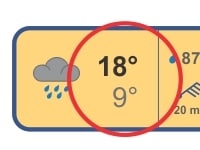
Minimum/Maximum Temperature
Apart from the weather symbol itself, the maximum/minimum temperature is probably the best indicator of what future weather conditions will be like. It is also the part of the weather report most people pay attention to, as most of us would like to know how to dress and plan our day.
Therefore, temperature is clearly a vital part of getting an overall picture of the predicted atmospheric conditions. It is normally measured in degrees Fahrenheit or Celsius (depending on your country's system of measurement).
To find out more about temperature, how it is measured, and its influence on the weather, you can find all this information in this article.
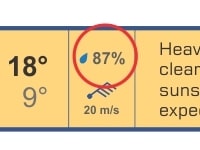
Likelihood Of Precipitation In Percentages
Almost as important as the temperature is the predicted likelihood of rainfall. Who of us does not want to know whether it is going to rain and what the chances of actual rainfall are?
Like temperature, your country's system of measurement will determine whether rainfall is measured in inches or millimeters.
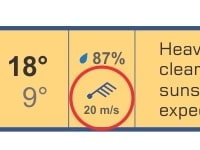
Wind Speed And Direction
Wind speed and direction indicators are not that widely used, especially by weather services aimed at providing forecasts for the general public.
It is no less important, though, and an important measurement for both weather enthusiasts and professional meteorologists.
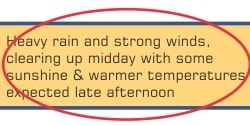
Short Text Summary
An often overlooked but very valuable part of a compact weather forecast is the text summary. You may understand some (or even all) of the symbols and additional information supplied with the weather symbol/icon.
An accurate text summary, however, rounds off the forecast by putting all the information into words to make sure everything is correctly understood.
iPhone Weather Symbols And Their Meaning
Just like all other smartphones and tablets, the popular iPhone and iPad also make use of weather symbols and icons to display weather information.
Although their icons may look slightly different than other devices, they serve the same purpose, and one won't have any difficulty understanding the meaning of each symbol.
The following list showcases some of the most common iPhone weather icons:
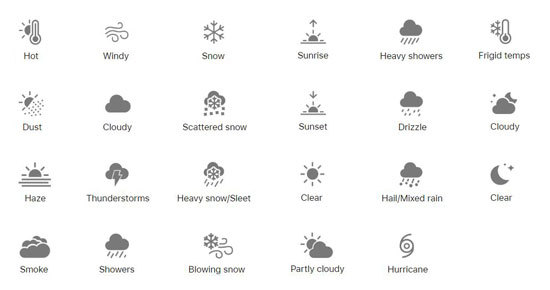
The illustration above shows some of the commonly used iPhone weather symbols and icons. Click on the image for a larger view.
Conclusion
If all the symbols and information displayed in a weather forecast didn't make sense to you before, you should now have a much clearer picture of what all the different elements mean and how to interpret them.
The primary goal of this article was to make sure you get a better understanding of the different weather forecasting symbols and elements to help you be better prepared for upcoming weather conditions.
The focus in this post was more on forecasting and all elements associated with it. For this reason, I didn't pay much attention to the details of an actual weather map. I am addressing all the features, symbols, and lines found in a weather map in this article.
Feel free to leave me any comments, questions, or suggestions, and I will get back to you as soon as possible.
Never miss out again when another interesting and helpful article is released and stay updated, while also receiving helpful tips & information by simply following this link .
Until next time, keep your eye on the weather!

